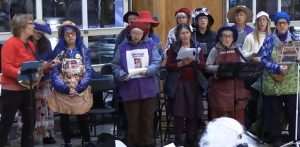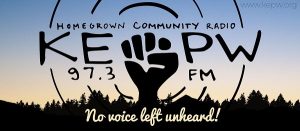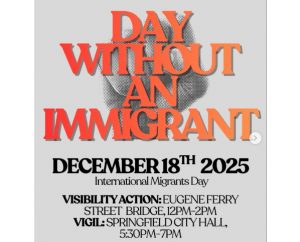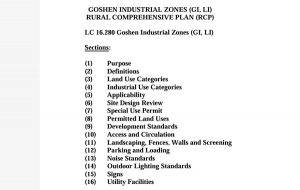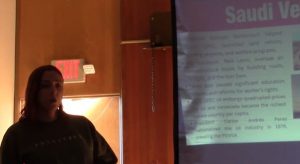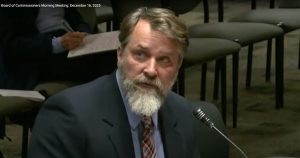Jameson Auten: Tell us how LTD can best meet the new needs of our community
9 min read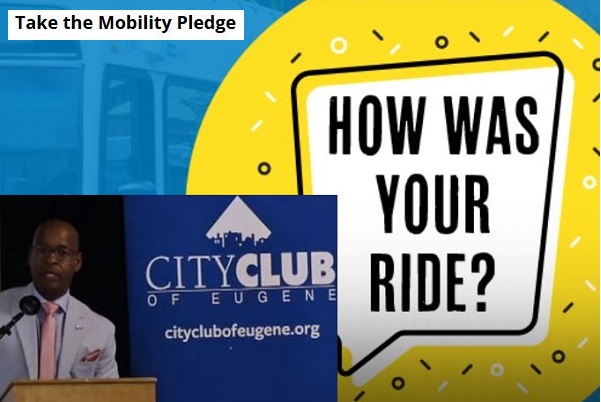
Presenter: LTD’s general manager and chief executive officer visited the Eugene City Club April 25 with an update for the community and a request. Jameson Auten:
Jameson Auten (LTD, CEO): We’re a part of the community, so we look at: How do we serve our community?
So we’re going to give an update on where we are in terms of our activities within Eugene. And we’re going to have an ask, ‘What do we need to help move the system forward?’ from you all.
[00:00:26] And when you think about your transit system, I can talk to you about ridership all day long, but the real beauty of it is: What are the outcomes? And how do those outcomes of that expenditure relate to the priorities that exist in our community?
[00:00:41] One of the things that we’ve done over the past year was we’ve created a position called a ‘community liaison.’ And this person joined us, previously in a nonprofit and spent some time in a low-barrier shelter to get the understanding on what that looks like, and is very active in the houseless community. And she helps us to understand how to implement policy.
[00:01:06] So she’s worked with our Public Safety team to say, ‘Hey, if this happens, this may be the cause of why that individual is acting up. Maybe they need a bottle of water. Or maybe they need a protein bar,’ and the problem’s gone. You don’t have to stretch EPD’s (Eugene Police Department) resources, it takes care of that.
[00:01:23] Maybe the person needs a change of clothing or needs to clean up. We were able to work with, again, another group to provide these huge body wipes that people use. Now, I’ve got to tell you, when I first saw that, in my mind, I’m going, ‘What is that?’
I was down at Eugene Station and a person said, ‘The people on the bus don’t like how I smell, and there’s nothing I can do about it.’ And the Public Safety officer gave him one of the wipes. He was able to do what he needed to do and get on his way.
[00:01:55] Another thing that stops people from riding public transportation is shoes, the lack of shoes. We had people who were being released from the hospital, and they didn’t have shoes, so they couldn’t ride the bus. Safety issue, right? So our community liaison officer found a quick solution.
[00:02:12] For a dollar a pair, we have these really thin slippers that have rubber soles that are compliant with our safety policy. We’re providing those to PeaceHealth and PeaceHealth is distributing them and now people can get back and forth on the bus. We don’t have to turn them away or we don’t have to delay them to get some other form of transportation. Simple solutions that are community-based.
[00:02:36] We’ve had our community liaison go take trainings and get involved with Truckers Against Trafficking and other groups and bring that back into our organization and incorporate that into our training and into our processes along with Public Safety. And again, she opened our eyes to where we can intersect with needs of our community.
[00:02:54] We’re not training our bus operators to be detectives or to chase and tackle people, but we are training them to recognize signs and to be able to call things in.
[00:03:05] We have 113 buses and you know, they’re not all out there at the same time. But we have a lot of roving eyes and cameras that are out in our community. And we feel that we can add value as we’re doing the work.
[00:03:18] The other thing that we’re getting involved in is Missing and Murdered Indigenous Women. Again, eyes out, you know, we have roaming camera systems. So we’re trying to leverage what’s already there to help in other community ways.
[00:03:32] You may have heard that there’s a potentially new YMCA coming to town. We sold our Hunsaker property, a big, almost five-acre plot on River Road, and we listened to the neighborhood associations before we did anything, and we heard what they want. They’re very good at communicating that and I appreciate that.
[00:03:52] There’s also a seven-year-old, eight-year-old transit station right next to it and it helps to densify that corridor. So we’re going to have conversations around: How do we help to support what the city wants to do in terms of safety improvements for that corridor?
[00:04:06] If you ever ride our Route 51 or 52, you’ll see a lot of students ride our buses. A lot. And when I see them cross that street at that intersection, it can be a little hairy. So we feel that from a system standpoint, the safety needs to be raised on that corridor.
[00:04:23] We’re continually tracking new and upcoming housing. There’s in West Eugene a lot of apartments just past where our EmX line stops and to the west of that. We see there’s a ton of apartments there. There used to be bus service there. There’s modifications to that in the plans. The Route 36, I believe, would be extended to go and serve that area.
[00:04:44] We’re looking at other opportunities. You know, 1059 Willamette happens to be directly across the street from Eugene Station. Is there a way to tie in a monthly mobility pass—whether it’s just with LTD, or if it’s incorporated in bike share, or if it’s incorporated with TNCs (transportation network companies like Uber and Lyft)—that is attached to the monthly rent of some of those apartments? And how much does that help people save on their monthly costs by giving them access to an asset that’s directly across the street?
[00:05:15] We’ve heard a lot about food insecurity, and we have a on-demand program that’s going to serve south of Cottage Grove, part of Marcola, and part of Mapleton on different days to be able to connect people with healthy food options, and we’re going to measure for that.
[00:05:33] Now the other ask I’ll say is: There’s a lot of that need in the community. In our county, if you look at the United Way ALICE Report—which is the Asset Limited Income Constrained Employed (working, can’t make ends meet)—some communities are 70%, 72%, 74% of households in that boat, and we’re trying to solve with that lens in place.
So as the legislature puts together the transportation package, the funds that support those programs are critical. And we’re having those conversations now.
[00:06:07] Presenter: He said it’s important to look at the entire system. Jameson Auten:
[00:06:12] Jameson Auten (LTD, CEO): We have a lot of service in Eugene and Springfield, but really our charge is Lane County. So we look at: How do we connect Lane County? How do we do that along with willing partners like the folks over at LCOG (Lane Council of Governments) who handle a lot of the rural transportation that connects into Eugene and connects along the coast? I think it’s important that we look at it as a system.
[00:06:31] It’s a system. A bus is a big part of it. So is bike share. So is pedestrian. So is carpool. So is vanpool. So is driving your own vehicle from time to time, OK, let’s be honest.
[00:06:43] We do about more than six million trips a year, and you know, when we first got here we had a big growth. In 2023, we went up about 20%. Last year we went up about 6%.
[00:06:54] In terms of our ADA paratransit, we do about 110,000 trips a year on that service. We’re proud that we have a system here that goes well beyond. We have ADA paratransit, we have microtransit, we have different services that take you where you need to be. And we continue to invest in that area.
[00:07:10] We have about 113 vehicles. Close to 30% of those are battery-electric buses. Have you ever been on a battery-electric bus? Yeah, yeah, we have some of those. We’re buying more buses. They’re not going to be battery-electric.
[00:07:24] We have about 360 employees—some of the best employees that you’ll find around the county. When I first came here, the overwhelming sense to serve community was what came across to me clearly. So that’s a good thing and we value our employees tremendously.
[00:07:40] We negotiated several labor contracts. We’re proud of our relationship with our labor group, which is ATU (Amalgamated Transit Union), and we work as a partnership. We don’t butt heads a lot. We have occasional things, but we generally get through our discussions, our big discussions, really, in a timely manner. So I appreciate that relationship.
[00:07:59] We’re starting to go into a process that we’ve branded ‘LTD Connect 2045,’ our long-range mobility plan. That takes into consideration the goals of the jurisdictions and the citizens that we serve here, right? So how does it impact climate goals? How does it impact congestion goals? And how do we leverage all of the pieces of that system to work well together?
[00:08:22] We’ll be kicking that off, so we’ll be working with groups to look at what are non-traditional metrics that we can use and share with the community that are easily digestible, make sense, and we can actually track around the areas of access to jobs, access to education, health care services, and housing options.
[00:08:41] We also had a community engagement framework that we created. A few years back, do you remember there was some excitement along the River Road corridor related to EmX? We put together a 26-member steering committee that had not one LTD person on it. We got external people to participate. And what came out of that was an approach for how we communicate with our communities and how we move forward with our outreach. Our board adopted that, the summer of ’24, and we’re operationalizing that right now.
[00:09:15] And then finally, we’re doing a systems review. We hear a lot of calls for service. We hear calls for service out of Creswell, we hear calls for service in Cottage Grove, we hear calls for service right here in South Eugene, and we’re aware of those things. What this system review does, it looks at: What’s running right now? How is it running? How can we make tweaks to make it run more efficient?
[00:09:37] As you know, we’re a hub-and-spoke system. You come into downtown and you go where you need to go, but Beltline often gets you there faster, would you agree? So we’re looking at how do we put service out there that helps us compete with the automobile from a travel-time standpoint.
[00:09:53] What do we need from you? What’s the ask? We need your voices. We need your input. You know when I first got here, one of the things that I heard was, ‘You know, LTD doesn’t take in the community input,’ or ‘LTD is making decisions in a vacuum,’ ‘Your board is not elected,’ ‘Your job should be elected.’ So what we’ve done is we’ve said, ‘Okay. We want to listen. We want to build with the community.’
[00:10:20] People commute differently. People are using all kinds of services differently. So we’re trying to figure out how we best meet the new need for public transportation. So if you can take the challenge, if you can go out and try one of the modes, that would be helpful for us.
[00:10:36] Try the bus service, try taking a walk, try renting a bicycle, try riding your own bicycle on one of the bike lanes, and tell us your experience so we can bake that into the planning that we’re about to do. And that’s our ask.
[00:10:50] Presenter: At City Club April 25, Jameson Auten asks community members to sign up for the mobility challenge. One trip each month, instead of driving alone, use transit, bike share, walking, or carpooling.
[00:11:03] And if you ride the bus, tell LTD what you think. An online survey is available through May 19.
